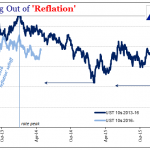The Federal Reserve is expected to raise interest rates again later this month, but if that’s another signal that headwinds are building for fixed-income securities the warning isn’t resonating in the junk bond market these days.
The crowd’s appetite for below-investment-grade US debt remains strong in the eighth year of a US economic expansion. By some accounts, the hour is late and so there’s reason to wonder if a full-throttle embrace of junk is wise. With yield spreads near post-recession lows and the expected trajectory of interest rates still pointing upward, the bears argue that low-grade corporate debt’s best days are in the rear-view mirror.
Yet the sentiment reflected in prices presents a different view, based on several widely held funds targeting US high-yield bonds. SPDR Bloomberg Barclays High Yield Bond (JNK), for example, closed yesterday near its all-time high. Ditto for iShares iBoxx $ High Yield Corp Bond (HYG) and Vanguard High-Yield Corporate Investment (VWEHX), which celebrates its 40th birthday in December.

Despite the long-running bull market in junk, trailing returns remain moderate. VWEHX, for instance, delivered an annualized 5.2% total return over the past five years through yesterday’s close (Sep. 11). That’s roughly double the return for iShares Core US Aggregate Bond (AGG), which tracks a popular benchmark that’s widely used as a broad investment-grade bogey for US bonds.
From a valuation perspective, however, the argument for caution isn’t easily dismissed. The ICE BofAML US High Yield Master II Option-Adjusted Spread has fallen to 3.4 percentage points – close to the lowest premium over a comparable Treasury yield since the recession ended in mid-2009.

One researcher last week opined that the US high-yield market has become a refuge of sorts for investors looking for an alternative to stormy weather in some corners of global markets — think emerging markets, for instance.














Leave A Comment